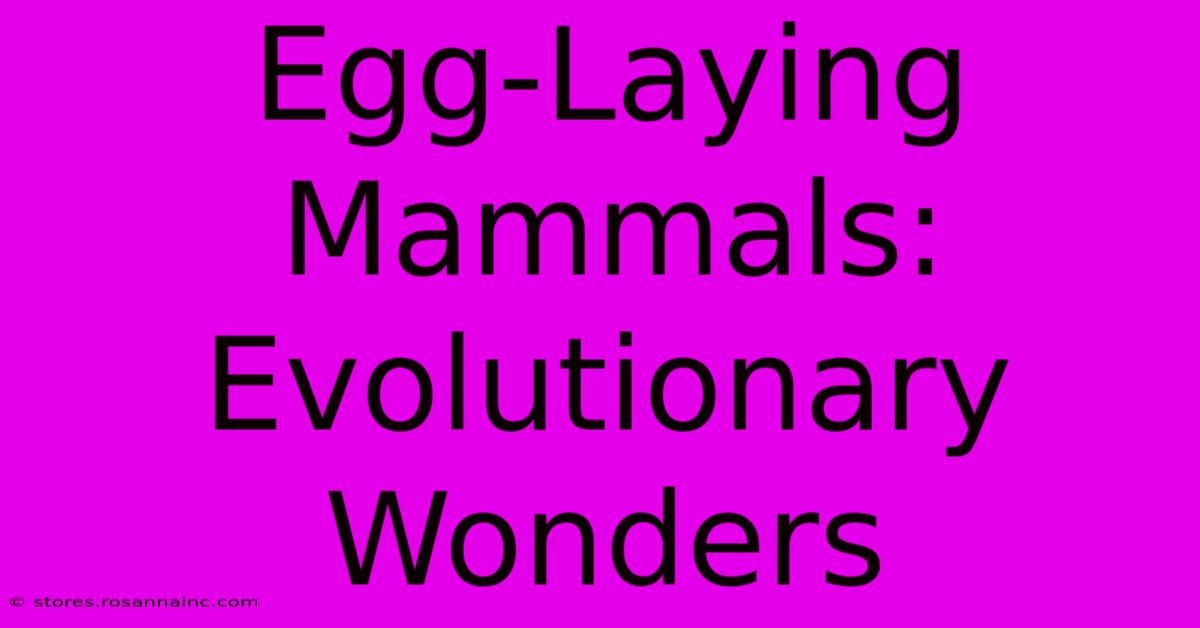Egg-Laying Mammals: Evolutionary Wonders

Table of Contents
Egg-Laying Mammals: Evolutionary Wonders
The animal kingdom is a breathtaking tapestry of diversity, and nowhere is this more evident than in the reproductive strategies employed by different species. While most mammals give birth to live young, a fascinating and relatively small group bucks this trend: the egg-laying mammals, also known as monotremes. These unique creatures represent a crucial link in our understanding of mammalian evolution, showcasing a remarkable blend of ancient and modern characteristics.
Understanding Monotremes: A Unique Branch of Mammalia
Monotremes are a truly ancient lineage, diverging from other mammals over 160 million years ago. This ancient divergence is reflected in their distinct reproductive strategy. Unlike marsupials and placental mammals, monotremes lay eggs, a characteristic more reminiscent of reptiles and birds. However, they also possess many definitively mammalian features, including:
- Mammary glands: Although they lack nipples, monotremes secrete milk to nourish their young. The milk is produced by specialized glands and is lapped up by the young from the mother's fur.
- Hair/fur: They possess a covering of fur, providing insulation and protection.
- Three middle ear bones: This is a defining characteristic of mammals, crucial for hearing.
- Warm-blooded: Monotremes maintain a relatively constant body temperature.
This combination of reptilian and mammalian traits makes monotremes incredibly valuable to scientists studying the evolutionary path of mammals. They offer a rare glimpse into the transitional stages of mammalian development.
The Two Families of Egg-Laying Mammals
Only five species of monotremes exist today, all endemic to Australia and New Guinea. These are divided into two families:
-
Echidnas (Tachyglossidae): These spiny anteaters are characterized by their long snouts, powerful claws, and a spiny coat. They are insectivores, using their long tongues to extract ants and termites from the ground. There are four species of echidna.
-
Platypuses (Ornithorhynchidae): This unique semi-aquatic mammal possesses a duck-like bill, webbed feet, and a dense, waterproof fur coat. It feeds primarily on aquatic invertebrates. The platypus is the only surviving member of its family.
The Egg-Laying Process: A Closer Look
The egg-laying process in monotremes is fascinating. Female monotremes lay a single, leathery-shelled egg, which is incubated for approximately 10 days (echidnas) or longer (platypus). The eggs are relatively large compared to the size of the mother. After hatching, the young remain in the burrow for several months, nursing on their mother's milk.
Evolutionary Significance of Monotreme Reproduction
The retention of egg-laying in monotremes offers crucial insights into the evolutionary trajectory of mammals. It suggests that the common ancestor of all mammals may have also laid eggs, with live birth evolving later in other mammalian lineages. Studying the genetics and developmental biology of monotremes could reveal vital information about the transition from egg-laying to live birth in mammals.
Conservation Status and Threats
All monotreme species face varying levels of conservation concerns. Habitat loss, pollution, and introduced predators are significant threats to their survival. Climate change poses an additional challenge, potentially altering their habitat and impacting their food sources. Conservation efforts are crucial to ensuring the survival of these remarkable creatures and preserving their unique place in the evolutionary history of mammals.
Conclusion: Celebrating the Wonders of Egg-Laying Mammals
Egg-laying mammals, or monotremes, represent a captivating chapter in the story of evolution. Their unique reproductive strategy, combined with their distinctive anatomical features, makes them incredibly valuable for understanding the evolutionary history of mammals. Continued research and conservation efforts are essential to ensure that these extraordinary animals continue to thrive for generations to come. Their survival is a testament to the enduring power and beauty of biodiversity.

Thank you for visiting our website wich cover about Egg-Laying Mammals: Evolutionary Wonders. We hope the information provided has been useful to you. Feel free to contact us if you have any questions or need further assistance. See you next time and dont miss to bookmark.
Featured Posts
-
Unlock The Heart Of Mexico Exploring Its National Anthem Lyrics
Feb 10, 2025
-
Musk Doge Et Les Jeunes Investisseurs
Feb 10, 2025
-
Aston Villa Vs Tottenham Fa Cup Teams
Feb 10, 2025
-
Celtics Defense Silences Towns
Feb 10, 2025
-
The Terror Unlocking The Secrets Of Dan Simmons Arctic Nightmare
Feb 10, 2025
